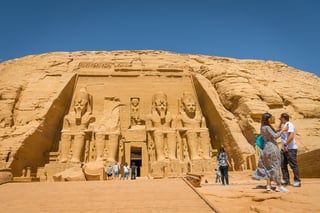Abu Simbel stands as one of the most remarkable monuments of ancient Egypt, built by the renowned Pharaoh Ramses II.
This colossal temple complex showcases the ambition of Ramses II's reign and serves as a testament to modern engineering and international cooperation. Discover the rich history, stunning architecture, and key features of Abu Simbel in this detailed guide.

Preservation Efforts: A Race Against Time
Abu Simbel's relocation and preservation became a global effort when the Aswan High Dam threatened to flood the site in the 1960s. An international UNESCO team embarked on a mission to dismantle and transport the entire temple complex to its current location.
This monumental endeavor ensured the preservation of this historic treasure.
The Colossi: Ramses II's Pursuit of Immortality
The awe-inspiring facade of Abu Simbel is adorned with colossal stone statues of Ramses II, depicting his quest for immortality. These massive figures continue to captivate visitors as they once did with the pharaoh's subjects.
Location and Visit
Situated 280 kilometers south of Aswan, most tourists opt for a day trip from Aswan to Abu Simbel. However, staying in Abu Simbel village allows for a more immersive experience amid these ancient wonders.
Exploring Abu Simbel: A Visitor's Guide
Temple of Ramses II
Forecourt & Terrace
The temple's main courtyard, originally enclosed by brick walls, offers a glimpse into ritual ablutions with stelae depicting Ramses II making offerings. A decorative frieze along the terrace portrays various people paying homage to the pharaoh.
Colossi of Ramses II
Four colossal statues carved from solid rock guard the temple's facade. These statues, representing a deified Ramses II, wear the double crown of Egypt and are accompanied by figures of the royal family and prisoners.
Hypostyle Hall
The grand entrance leads to the Hypostyle Hall, featuring massive Osiris figures of Ramses II and captivating ceiling paintings of vultures and stars. Side chambers served as treasuries and store rooms.
Battle of Qadesh Reliefs
The Hypostyle Hall boasts iconic reliefs depicting Ramses II's campaign against the Hittites in the Battle of Qadesh. Scenes illustrate the Egyptian army on the march, a Council of War, enemy spies, and the battle itself.
Vestibule
The Vestibule is divided into three aisles and adorned with representations of Ramses II joining the company of the gods.
Transverse Chamber
This narrow chamber features reliefs of Ramses II making offerings to various deities, showcasing his devotion.
Sanctuary: House of the Gods
In the Sanctuary, Ramses II is depicted burning incense, while larger-than-life figures symbolize his equality with the gods. The sacred barque base is a prominent feature.
History of Abu Simbel: Ramses II's Propaganda
Ramses II's motivation for constructing Abu Simbel remains a subject of speculation. The temples symbolize his royal and divine claim to rule the resource-rich region of Nubia. Throughout history, various travelers left inscriptions and graffiti on the site, reflecting the circumstances of their time.
Preservation and Relocation
The temples faced new threats when the Aswan High Dam construction commenced in 1960. UNESCO orchestrated a massive rescue operation, ultimately leading to the relocation and preservation of Abu Simbel.
Various proposals were considered, but the temples were ultimately sawn into blocks and re-erected on higher ground.
Temple of Hathor
Adjacent to the Great Temple of Ramses II is the Temple of Hathor, dedicated to the goddess of love and Ramses' wife, Queen Nefertari.
This smaller temple boasts impressive colossi, a Hypostyle Hall with valuable reliefs, and a Sanctuary.
Tips and Tours: Making the Most of Your Visit
- Private tours from Aswan offer convenience and flexibility, with early morning departures to avoid crowds.
- Consider staying the night in Abu Simbel for a more immersive experience.
- Attend the nightly sound and light show for a unique perspective on the temples.
- Witness the Abu Simbel Sun Festival on February 21 and October 21, when sunlight illuminates the temple's inner sanctum.
Getting to Abu Simbel
- Tour buses, private taxis, and flights from Aswan are common transportation options.
- A public bus service also operates from Aswan, offering a budget-friendly choice.
- Lake Nasser cruise boats provide a scenic journey and temple exploration along the way.
Abu Simbel stands as an enduring testament to Ramses II's legacy, a symbol of Egypt's rich history, and a marvel of preservation and international cooperation.


To help us improve